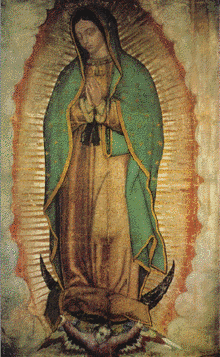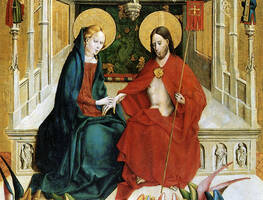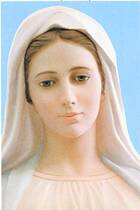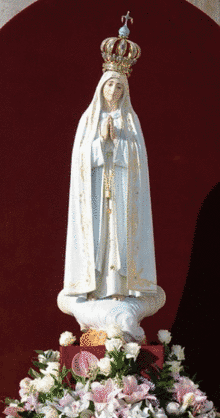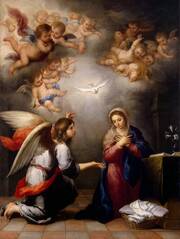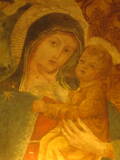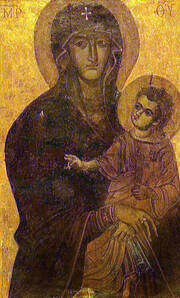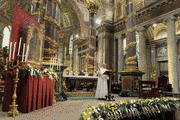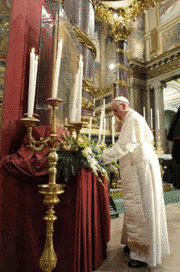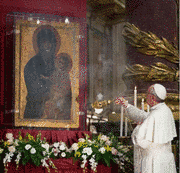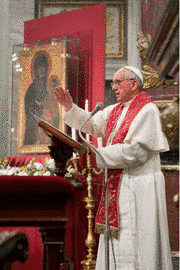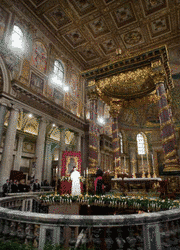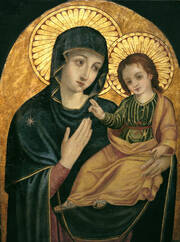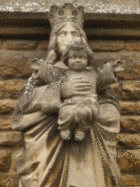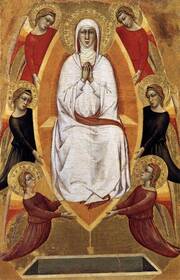Our Lady, Mother Mary
Mary in her 'fiat', her 'yes' to God, became the mother of our Saviour, the ark of the New Covenant. Jesus, from the Cross, gave his mother to his beloved disciple, saying 'This is your mother'. From that moment on, the Apostle John took Mary into his home and into his heart, as have the saints down through the last 20 centuries. Our Lady is known by many titles, but at the heart of all others is her role as our mother, ever compassionate, tender and loving (as witnessed to in the 3000+ responses on Something about Mary).
Mother Teresa: "If you ever feel distressed during your day - call upon Our Lady. Just say this simple prayer: 'Mary, Mother of Jesus, please be a mother to be now.' This prayer has never failed me."
Our Lady has appeared to her children throughout the ages (eg in Walsingham, England, in 1061; in Mexico City in 1531, in Lourdes, France, in 1858), but never so frequently as during this last century, eg in Fatima, Rwanda, Egypt, & most recently Medjugorje, in Bosnia-Hercegovina (no final decision has yet been reached by the Vatican on the veracity of these apparitions but official pilgrimages have been sanctioned).
Feast days of Our Lady include: her Immaculate Conception (8th December), her birthday (8th September), her Assumption into heaven (15th August), her Queenship (22nd August), the Immaculate Heart of Mary (day after the Sacred Heart of Jesus), Theotokos, Mother of God (1st January) and Mother of the Church (Monday after Pentecost). Her titles include: Our Lady of Aparecida, of Czestochowa, of Fatima, of Guadalupe, of Knock, of Loreto, of Lourdes, of Medjugorje, of the Miraculous Medal, of Mount Carmel, of Perpetual Help, of the Rosary, of Sorrows, of Walsingham.
Mary is greatly loved by our Holy Fathers - on the morning after his election, Pope Francis began by visiting Our Lady, Populis Romani, and asked for his papacy to be consecrated to Our Lady in Fatima on 13th May. Papa Benedict XVI ended all his homilies and encyclicals with reference to Our Lady, and his last pilgrimage was to her shrine in Loreto, just before the Year of Faith began. St John Paul II gave everything to Jesus through Mary, as his motto Totus Tuus highlighted (his first pilgrimage was to Our Lady of Guadalupe, his last 'abroad' was to Lourdes & his last in Italy was also to Loreto). The assassination attempt on his life in 1981 was on the Feast of Our Lady of Fatima & JPII was very aware that it was Our Lady who had saved his life.
JPII wrote his encyclical Redemptoris Mater, his apostolic letter Litterae Encyclicae, gave 70 catecheses (between 1995-97) on Our Lady. and made a consecration to her in the Jubilee Year 2000 in the presence of the bishops of the world. Paul VI wrote his encyclical Marialis Cultus on Our Lady & his apostolic exhortation Signum Magnum on the feast of Our Lady of Fatima 1967.
Pope St John Paul II's Catechesis on Mary, Mother of the Risen Christ 
General Audience, Wednesday 2 May 1979 - also in French, Italian, Portuguese & Spanish
"1. Regina caeli laetare, alleluia / quia quem meruisti portare, alleluia / resurrexit, sicut dixit, alleluia / ora pro nobis Deum, alleluia.
I desire to dedicate today's general audience in a particular way to the Mother of the Risen Christ. The Easter period permits us to address her with the words of pure joy, with which the Church greets her. The month of May, which began yesterday, encourages us to think and speak of her in a particular way. In fact this is her month. Thus the period of the liturgical year and the current month together call and invite us to open our hearts to Mary in a special way.
2. With her Easter antiphon 'Regina Caeli', the Church speaks to the Mother, to her who had the good fortune to bear in her womb, under her heart and later in her arms, the Son of God and our Saviour. She took him in her arms for the last time when he was taken down from the Cross, on Calvary. Before her eyes, he was wrapped in the shroud and taken to the tomb. Before her Mother's eyes! And on the third day the tomb was found empty. But she was not the first to note it. First there were the "three Marys" and among them particularly Mary Magdalen, the converted sinner. Informed by the women, the apostles ascertained it shortly thereafter. And even if the Gospels do not tell us anything about the visit of Christ's Mother to the place of his Resurrection, we all nevertheless think that she must in some way have been the first one present. She must have been the first to participate in the mystery of the Resurrection, because such was her right as Mother.
The liturgy of the Church respects this right of the Mother, when it addresses to her this particular invitation to the joy of the Resurrection: "Laetare! Resurrexit sicut dixit!" And the same antiphon immediately adds this request for intercession: "Ora pro nobis Deum." The revelation of the divine power of the Son by means of the Resurrection is at the same time the revelation of the "omnipotence of intercession" (omnipotentia supplex) of Mary before this Son.
3. The Church of all times, beginning with the Cenacle of Pentecost, always surrounds Mary with particular veneration and addresses her with special trust. The Church of our times, through the Second Vatican Council, has made a synthesis of all that had developed through the generations. Chapter eight of the dogmatic Constitution Lumen Gentium is in a certain sense a 'magna charta' of Mariology for our times: Mary present in a particular way in the mystery of Christ and in the mystery of the Church; Mary, "Mother of the Church", as Paul VI began to call her (in the Credo of the People of God), subsequently dedicating to her a separate document (Marialis Cultus).
This presence of Mary in the mystery of the Church, that is at the same time in the daily life of the People of God all over the world, is above all a maternal presence. Mary, so to speak, gives to the salvific work of the Son and to the mission of the Church a singular form: the maternal form. Everything that can be stated in the human language on the theme of the "genius" proper to woman-mother — the genius of the heart — all this refers to her.
Mary is always the fullest accomplishment of the salvific mystery — from the Immaculate Conception to the Assumption — and she is continually a very efficacious pre-announcement of this mystery. She reveals salvation, she brings grace closer even to those who seem the most indifferent and the most distant. In the world, which together with progress manifests its "corruption" and its "aging", she is unceasingly "the beginning of the better world" (origo mundi melioris), as Paul VI put it. "To contemporary man," — wrote the late Pontiff — “the blessed Virgin Mary... offers a serene vision and a reassuring word: the victory of hope over anguish, of communion over solitude, of peace over agitation, of joy and beauty over boredom and nausea.., of life over death" (Paul VI, Marialis Cultus, 57).
4. To her, to Mary who is the Mother of fair Love, I desire to bring closer in particular the youth of all the world and of all the Church. She bears within herself an indestructible sign of youthfulness and beauty which never pass. I desire and pray that the young will approach her, will have trust in her, that they will entrust to her the life that is before them; that they will love her with a simple and burning love of the heart. She alone is capable of responding to this love in the best way:
"Ipsam sequens non devias,
ipsam rogans non desperas,
ipsam cogitans non erras...
ipsam propitia — pervenis..." (St Bernard, Homilia II super Missus est. XVII).
To Mary who is Mother of divine grace I entrust priestly and religious vocations. May the new spring of vocations, their new increase throughout the Church, become a particular proof of her maternal presence in the mystery of Christ, in our times, and in the mystery of his Church all over the earth. Mary alone is a living incarnation of that total and complete dedication to God, to Christ, to his salvific action, which must find its adequate expression in every priestly and religious vocation. Mary is the fullest expression of perfect faithfulness to the Holy Spirit and to his action in the soul; she is the expression of the faithfulness which means persevering cooperation in the grace of vocation.
In the whole Church next Sunday is appointed to prayer for vocations to the priesthood and to the religious life. It is Vocations Sunday. Through the intercession of the Mother of divine grace, may it bring an abundant harvest.
5. To the Mother of Christ and of the Church I dedicate all the world, all the nations on earth, all men and women, because she is Mother of them all. To her I dedicate particularly those for whom life is more difficult, more severe, those who are suffering physically or spiritually, who are living in poverty, who are subjected to injustice or harm.
In a special way, however, concluding this May meditation, I desire to venerate, tomorrow, Mary in Jasna Gora (Bright Mountain) at Czestochowa and in the whole of my country. I used to go there on pilgrimage every year on 3 May, which is the feast of the Queen of Poland. Every year I celebrated a solemn mass there, during which Cardinal Wyszynski, Primate of Poland, in the presence of the Episcopate and of the immense crowd of pilgrims, renewed the act of consecration of Poland to the "maternal bondage" of Our Lady. This year too, God willing, I will visit Jasna Gora on the 4th and 5th June. Tomorrow instead I will be there in spirit and in heart, so as to repeat together with the whole Church, together with all of you gathered here in this splendid St Peter's Square: "Regina caeli laetare, alleluia"!"
Our Lady and her apparitions
in Lourdes, Fatima & Medjugorje 
Fr John Edwards SJ: "I don’t know what more God could do to point to the message of Lourdes and Fatima. The message of Medjugorje? The same - prayer and penance, and the prayer Our Lady mentions is the rosary. Why? Because with these things - prayer, penance, fasting - she says then we'll be converted, turned around, twisted, linked to her Son. And if we can do that, then peace. Our Lady is not just talking about international peace (she says the world is on the brink of disaster, well, we know that) but she's talking about peace where it's got to begin, in your heart, in my heart. I think heaven is shouting to us. I think heaven for 150 years through the Mother of God, who brought Jesus to us, is giving us in the technical sense a prophecy. " (Length of talk: 12 mins - given in 1987)
The Marian day in the Year of Faith was celebrated on 13 October 2013 (the anniversary of the miracle of the sun in Fatima), with Pope Francis's Act of Entrustment to Mary at the end of Mass in St Peter's Square:
"Blessed Virgin Mary of Fatima,
with renewed gratitude for your maternal/motherly presence
we join our voice to that of all the generations
that call you blessed.
We celebrate in you the great works of God,
who never tires of bending/stooping down in mercy over humanity,
afflicted by evil and wounded by sin,
so as to heal it and to save it.
Accept with the benevolence of Mother
the act of entrustment that we make today with confidence,
before this your image so dear to us.
We are certain that each one of us is precious in your eyes
and that nothing is estranged from you of all that lives in our hearts.
Let us reach your sweet gaze
and receive the consoling caress of your smile.
Guard our lives in your arms:
bless and strengthen every desire for good;
revitalise and nourish faith;
sustain and illuminate hope;
arouse/awaken and animate charity;
guide us all on the path of holiness.
Teach us your very own love of predilection/preferential love
for the little ones and the poor,
for the excluded and the suffering,
for sinners and the lost of heart:
gather everyone under you protection
and consign everyone to your beloved Son, our Lord Jesus. Amen."
Carlene, from England ![]()
"For me, Mary is champion of the world, like the utter containment of perfection in a woman. She’s like who you wanna be like, she’s like the queen, the mother .. and yet so humble. .. She’s the first one, the new Eve, the first to say yes to God and lead us to salvation."
Papa Francis' Homily at Mass on the Marian Day in the Year of Faith
St Peter's Square, Sunday 13 October 2013 - in Arabic, English, French, German, Italian, Polish, Portuguese & Spanish
In the Psalm we said: “Sing to the Lord a new song, for he has done marvellous works” (Ps 98, 1).
Today we consider one of the marvellous things which the Lord has done: Mary! A lowly and weak creature like ourselves, she was chosen to be the Mother of God, the Mother of her Creator.
Considering Mary in the light of the readings we have just heard, I would like to reflect with you on three things: first, God surprises us, second, God asks us to be faithful, and third, God is our strength.
1. First: God surprises us. The story of Naaman, the commander of the army of the king of Aram, is remarkable. In order to be healed of leprosy, he turns to the prophet of God, Elisha, who does not perform magic or demand anything unusual of him, but asks him simply to trust in God and to wash in the waters of the river. Not, however, in one of the great rivers of Damascus, but in the little stream of the Jordan. Naaman is left surprised, even taken aback. What kind of God is this who asks for something so simple? He wants to turn back, but then he goes ahead, he immerses himself in the Jordan and is immediately healed (cf 2 Kg 5:1-4). There it is: God surprises us. It is precisely in poverty, in weakness and in humility that he reveals himself and grants us his love, which saves us, heals us and gives us strength. He asks us only to obey his word and to trust in him.
This was the experience of the Virgin Mary. At the message of the angel, she does not hide her surprise. It is the astonishment of realizing that God, to become man, had chosen her, a simple maid of Nazareth. Not someone who lived in a palace amid power and riches, or one who had done extraordinary things, but simply someone who was open to God and put her trust in him, even without understanding everything: “Here I am, the servant of the Lord; let it be to me according to thy word” (Lk 1, 38). That was her answer. God constantly surprises us, he bursts our categories, he wreaks havoc with our plans. And he tells us: Trust me, do not be afraid, let yourself be surprised, leave yourself behind and follow me!
Today let us all ask ourselves whether we are afraid of what God might ask, or of what he does ask. Do I let myself be surprised by God, as Mary was, or do I remain caught up in my own safety zone: in forms of material, intellectual or ideological security, taking refuge in my own projects and plans? Do I truly let God into my life? How do I answer him?
2. In the passage from St Paul which we have heard, the Apostle tells his disciple Timothy: Remember Jesus Christ; if we persevere with him, we will also reign with him (cf 2 Tim 2, 8-13). This is the second thing: to remember Christ always – to be mindful of Jesus Christ – and thus to persevere in faith. God surprises us with his love, but he demands that we be faithful in following him. We can be unfaithful, but he cannot: he is “the faithful one” and he demands of us that same fidelity. Think of all the times when we were excited about something or other, some initiative, some task, but afterwards, at the first sign of difficulty, we threw in the towel. Sadly, this also happens in the case of fundamental decisions, such as marriage. It is the difficulty of remaining steadfast, faithful to decisions we have made and to commitments we have made. Often it is easy enough to say “yes”, but then we fail to repeat this “yes” each and every day. We fail to be faithful.
Mary said her “yes” to God: a “yes” which threw her simple life in Nazareth into turmoil, and not only once. Any number of times she had to utter a heartfelt “yes” at moments of joy and sorrow, culminating in the “yes” she spoke at the foot of the Cross. Here today there are many mothers present; think of the full extent of Mary’s faithfulness to God: seeing her only Son hanging on the Cross. The faithful woman, still standing, utterly heartbroken, yet faithful and strong.
And I ask myself: Am I a Christian by fits and starts, or am I a Christian full-time? Our culture of the ephemeral, the relative, also takes it toll on the way we live our faith. God asks us to be faithful to him, daily, in our everyday life. He goes on to say that, even if we are sometimes unfaithful to him, he remains faithful. In his mercy, he never tires of stretching out his hand to lift us up, to encourage us to continue our journey, to come back and tell him of our weakness, so that he can grant us his strength. This is the real journey: to walk with the Lord always, even at moments of weakness, even in our sins. Never to prefer a makeshift path of our own. That kills us. Faith is ultimate fidelity, like that of Mary.
3. The last thing: God is our strength. I think of the ten lepers in the Gospel who were healed by Jesus. They approach him and, keeping their distance, they call out: “Jesus, Master, have mercy on us!” (Lk 17:13). They are sick, they need love and strength, and they are looking for someone to heal them. Jesus responds by freeing them from their disease. Strikingly, however, only one of them comes back, praising God and thanking him in a loud voice. Jesus notes this: ten asked to be healed and only one returned to praise God in a loud voice and to acknowledge that he is our strength. Knowing how to give thanks, to give praise for everything that the Lord has done for us.
Take Mary. After the Annunciation, her first act is one of charity towards her elderly kinswoman Elizabeth. Her first words are: “My soul magnifies the Lord”, in other words, a song of praise and thanksgiving to God not only for what he did for her, but for what he had done throughout the history of salvation. Everything is his gift. If we can realize that everything is God’s gift, how happy will our hearts be! Everything is his gift. He is our strength! Saying “thank you” is such an easy thing, and yet so hard! How often do we say “thank you” to one another in our families? These are essential words for our life in common. “Sorry”, “excuse me”, “thank you”. If families can say these three things, they will be fine. “Sorry”, “excuse me”, “thank you”. How often do we say “thank you” in our families? How often do we say “thank you” to those who help us, those close to us, those at our side throughout life? All too often we take everything for granted! This happens with God too. It is easy to approach the Lord to ask for something, but to go and thank him: “Well, I don’t need to”.
As we continue our celebration of the Eucharist, let us invoke Mary’s intercession. May she help us to be open to God’s surprises, to be faithful to him each and every day, and to praise and thank him, for he is our strength. Amen."
Click here to watch the celebration with the statue of Our Lady of Fatima & here for the Holy Rosary with various marian shrines of the world (both are being streamed live by the Vatican).
Papa Francis' Homily at Mass on the Marian Day in the Jubilee of Mercy
St Peter's Square, Sunday 9 October 2016 - in Arabic, English, French, German, Italian, Polish, Portuguese & Spanish
"This Sunday’s Gospel (cf Lk 17, 11-19) invites us to acknowledge God’s gifts with wonder and gratitude. On the way to his death and resurrection, Jesus meets ten lepers, who approach him, keep their distance and tell their troubles to the one whom their faith perceived as a possible saviour: “Jesus, Master, have mercy on us!” (v 13). They are sick and are looking for someone to heal them. Jesus responds by telling them to go and present themselves to the priests, who according to the Law were charged with certifying presumed healings. In this way, Jesus does not simply make them a promise; he tests their faith. At that moment, in fact, the ten were not yet healed. They were restored to health after they set out in obedience to Jesus’ command. Then, rejoicing, they showed themselves to the priests and continued on their way. They forgot the Giver, the Father, who cured them through Jesus, his Son made man.
All but one: a Samaritan, a foreigner living on the fringes of the chosen people, practically a pagan! This man was not content with being healed by his faith, but brought that healing to completion by returning to express his gratitude for the gift received. He recognized in Jesus the true Priest, who raised him up and saved him, who can now set him on his way and accept him as one of his disciples.
To be able to offer thanks, to be able to praise the Lord for what he has done for us: this is important! So we can ask ourselves: Are we capable of saying “Thank you”? How many times do we say “Thank you” in our family, our community, and in the Church? How many times do we say “Thank you” to those who help us, to those close to us, to those who accompany us through life? Often we take everything for granted! This also happens with God. It is easy to approach the Lord to ask for something, but to return and give thanks... That is why Jesus so emphasizes the failure of the nine ungrateful lepers: “Were not ten made clean? But the other nine, where are they? Was no one found to return and give praise to God except this foreigner?” (Lk 17, 17-18).
On this Jubilee day, we are given a model, indeed the model, to whom we can look: Mary, our Mother. After hearing the message of the Angel, she lifted up her heart in a song of praise and thanksgiving to God: “My soul magnifies the Lord…” Let us ask Our Lady to help us recognize that everything is God’s gift, and to be able to say “Thank you”. Then, I assure you, our joy will be complete. Only those who know how to say “Thank you”, will experience the fullness of joy.
It also takes humility to be able to give thanks. In the first reading we heard the singular story of Naaman, the commander of the army of the King of Aram (cf 2 Kg 5, 14-17). In order to be cured of his leprosy, he accepts the suggestion of a poor slave and entrusts himself to the prophet Elisha, whom he considered an enemy. Naaman was nonetheless ready to humble himself. Elisha asks nothing of him, but simply orders him to bathe in the waters of the River Jordan. This request leaves Naaman perplexed, even annoyed. Can a God who demands such banal things truly be God? He would like to turn back, but then he agrees to be immersed in the Jordan and immediately he is cured.
The heart of Mary, more than any other, is a humble heart, capable of accepting God’s gifts. In order to become man, God chose precisely her, a simple young woman of Nazareth, who did not dwell in the palaces of power and wealth, who did not do extraordinary things. Let us ask ourselves – it will do us good – if we are prepared to accept God’s gifts, or prefer instead to shut ourselves up within our forms of material security, intellectual security, the security of our plans.
Significantly, Naaman and the Samaritans were two foreigners. How many foreigners, including persons of other religions, give us an example of values that we sometimes forget or set aside! Those living beside us, who may be scorned and sidelined because they are foreigners, can instead teach us how to walk on the path that the Lord wishes. The Mother of God, together with Joseph her spouse, knew what it was to live far from home. She too was long a foreigner in Egypt, far from her relatives and friends. Yet her faith was able to overcome the difficulties. Let us cling to this simple faith of the Holy Mother of God; let us ask her that we may always come back to Jesus and express our thanks for the many benefits we have received from his mercy."
The Virgin Mary: Icon of Obedient Faith 
Catechesis with Papa Benedict XVI
"We find another hint of Mary's interior attitude in front of the action of God, again in the Gospel of St Luke, at the time of Jesus' birth, after the adoration of the shepherds. Luke affirms that Mary “kept all these things, meditating upon them in her heart” (Lk 2:19); in Greek the term is symballon, we could say that she “holds together”, “puts together” in her heart all the events that were happening; she placed each single element, each word, each fact within the whole and compared it, cherished it, recognizing that everything comes from the will of God. Mary does not stop at a first superficial understanding of what is happening in her life, but knows to look in depth, she lets herself be questioned by events, she digests them, discerns them, and acquires that understanding that only faith can guarantee. It is the profound humility of the obedient faith of Mary, who welcomes within her even what she does not understand in the action of God, leaving it to God to open her mind and her heart. “Blessed is she who believed in the fulfillment of the word of the Lord” (Lk 1:45), exclaims her kinswoman Elizabeth. It is precisely for her faith that all generations will call her blessed." (19.12.12)
Devotion to Our Lady 
Fr John Edwards SJ: "One word about devotion to Our Lady … You can hear people say 'Perhaps we overdo in the Catholic Church attention to the Mother of Jesus.' Well, I don't think we do. Two good reasons. The first one is this: if you want to please somebody, if you really want to give somebody joy, the thing to do is to praise someone whom they love very much. .. To praise the handiwork is to praise the author of it. Now to praise Mary is to praise God because God invented Mary. Just like to praise the Choral Symphony is to praise Beethoven - he invented it! "
Pope Francis's words about Our Mother Mary
in the Basilica of St Mary Major, 4 May 2013 - in Arabic, English, French, German, Italian, Polish, Portuguese & Spanish
" .. I thank you, brothers and sisters, who have come here today to pray to Our Lady, the Mother, the Salus Populi Romani [Health of the Roman people]. For tonight we are here before Mary. We have prayed under her motherly leadership that she guide us to be ever more united to her Son Jesus. We have brought her our joys and our suffering, our hopes and our struggles; we have invoked her by the beautiful title of Salus Populi Romani imploring her for us all, for Rome, for the world that she grant us health. Yes, because Mary gives us health, she is our health.
Jesus Christ, by his Passion, Death and Resurrection, has brought us salvation, granting us the grace and the joy of being children of God, of calling Him in truth with the name of Father. Mary is the mother, and a mother worries above all about the health of her children, she knows how to care for them always with great and tender love. Our Lady guards our health. What does this mean: Our Lady guards our health? I think above all of three things: she helps us grow, to confront life, to be free.
1. A mother helps her children grow up and wants them to grow strong; that is why she teaches them not to be lazy — which also derives from a certain wellbeing — not to sink into a comfortable life-style, contenting oneself with possessions. The mother takes care that her children develop better, that they grow strong, capable of accepting responsibilities, of engaging in life, of striving for great ideals. The Gospel of St Luke tells us that, in the family of Nazareth, Jesus “grew and became strong, filled with wisdom; and the favour of God was upon him” (Lk 2:40). Our Lady does just this for us, she helps us to grow humanly and in the faith, to be strong and not to fall into the temptation of being men and Christians in a superficial way, but to live responsibly, to strive always higher.
2. A mother then thinks of the health of her children, teaching them also to face the difficulties of life. One does not teach, one does not take care of health by avoiding problems, as if life were a motorway with no obstacles. The mother helps her children to look with realism at the problems of life and to not get lost in them, but to face them with courage, to not be weak, and to know how to overcome them, in a healthy balance that a mother “senses” between the areas of security and the zones of risk. And a mother can do this! She does not always take the child along the road of safety, because in this way the child cannot grow, but neither does she leave the child only on the road of risk, because that is dangerous. A mother knows how to balance things. A life without challenges does not exist and a boy or a girl who cannot face or tackle them is a boy or girl with no backbone! Let us remember the parable of the good Samaritan: Jesus does not propose the behaviour of the priest and the Levite, who avoid rescuing the man who was attacked by robbers, but the Samaritan who sees the situation of this man and confronts it in a concrete way, even with the risks. Mary saw many moments that were not easy in her life, from the birth of Jesus, when “there was no place for them in the inn” (Lk 2:7), to Calvary (cf Jn 19:25). And like a good mother she is close to us, so that we may never lose courage in the face of the adversities of life, in the face of our weakness, in the face of our sins: she gives us strength, she shows us the pathway of her Son. From the Cross Jesus says to Mary, pointing to John: “Woman, behold your son!” and to John: “Here is your mother!” (cf Jn 19:26-27). In this disciple we are all represented: the Lord entrusts us to the loving and tender hands of the Mother, so that we might feel her support in facing and overcoming the difficulties of our human and Christian pathway; to not be afraid of the difficulties, to face it with the help of the mother.
3. A final aspect: a good mother not only accompanies her children in their growth, by not avoiding the problems, the challenges of life; a good mother also helps them to make definitive decisions with freedom. This is not easy, but a mother knows how to do it. But what does freedom mean? It is certainly not doing whatever you want, allowing yourself to be dominated by the passions, to pass from one experience to another without discernment, to follow the fashions of the day; freedom does not mean, so to speak, throwing everything that you don’t like out the window. No, that is not freedom! Freedom is given to us so that we know how to make good decisions in life! Mary as a good mother teaches us to be, like her, capable of making definitive decisions; definitive choices, in this moment in which, so to speak, a philosophy of the provisional reigns. It is so difficult to engage in life definitively. And she helps us to make definitive decisions with this full freedom with which she answered “yes” to the plan of God for her life (c. Lk 1:38).
Dear brothers and sisters, how hard it is, in our time, to make definitive decisions! In everything we are seduced by the provisional. We are victims of a trend that pushes us to temporariness... as though we wanted to remain adolescents. There is little charm in remaining adolescents, and this for the whole of life! Let us not be afraid of definitive commitments, commitments that involve and concern our whole life! In this way life will be fruitful! And this is freedom: to have the courage to make these decisions with greatness.
Mary’s whole existence is a hymn to life, a hymn of love to life: she generated Jesus in the flesh and accompanied the birth of the Church on Calvary and in the Upper Room. The Salus Populi Romani is the mother who gives us health in growth, gives us health in facing and overcoming problems, gives us the health to make us free to make definitive choices; the mother who teaches us to be fruitful, to be open to life and to be always fruitful in the good, fruitful in joy, fruitful in hope, to never lose hope, to give life to others, physical and spiritual life.
This we ask tonight, O Mary, Salus Populi Romani, for the people of Rome, for all of us: give us the health that you alone can give us, to be ever a sign and instrument of life. Amen."
* * *
Upon leaving the Basilica, the Holy Father spoke the following words from the steps to the people gathered in the Square:
"Dear brothers and sisters, good evening! Thank you very much for your presence in the house of the Mother of Rome, of our Mother. Long live the Salus Populi Romani. Long live Our Lady. She is our Mother. Let us entrust ourselves to her, because she cares for us like a buona mamma [good mum]. I pray for you, but I ask you to pray for me, because I need it. Three Hail Mary’s for me. I wish you a good Sunday tomorrow. Goodbye. Now I give you my Blessing — to you and to your whole family. May God Almighty bless you. Have a good Sunday."
Deus Caritas Est ![]()
Papa Benedict XVI ended his encyclical on Love by speaking about Our Lady:
"Outstanding among the saints is Mary, Mother of the Lord and mirror of all holiness. In the Gospel of Luke we find her engaged in a service of charity to her cousin Elizabeth .. “My soul magnifies the Lord.” In these words she expresses her whole programme of life: not setting herself at the centre, but leaving space for God, who is encountered both in prayer and in service of neighbour — only then does goodness enter the world. Mary's greatness consists in the fact that she wants to magnify God, not herself. She is lowly: her only desire is to be the handmaid of the Lord. She knows that she will only contribute to the salvation of the world if, rather than carrying out her own projects, she places herself completely at the disposal of God's initiatives.
Mary is a woman of hope: only because she believes in God's promises and awaits the salvation of Israel, can the angel visit her and call her to the decisive service of these promises. Mary is a woman of faith: “Blessed are you who believed”, Elizabeth says to her. The Magnificat — a portrait, so to speak, of her soul — is entirely woven from threads of Holy Scripture, threads drawn from the Word of God. Here we see how completely at home Mary is with the Word of God, with ease she moves in and out of it. She speaks and thinks with the Word of God; the Word of God becomes her word, and her word issues from the Word of God. Here we see how her thoughts are attuned to the thoughts of God, how her will is one with the will of God. Since Mary is completely imbued with the Word of God, she is able to become the Mother of the Word Incarnate. Finally, Mary is a woman who loves. How could it be otherwise? As a believer who in faith thinks with God's thoughts and wills with God's will, she cannot fail to be a woman who loves. We sense this in her quiet gestures, as recounted by the infancy narratives in the Gospel. We see it in the delicacy with which she recognizes the need of the spouses at Cana and makes it known to Jesus. We see it in the humility with which she recedes into the background during Jesus' public life, knowing that the Son must establish a new family and that the Mother's hour will come only with the Cross, which will be Jesus' true hour. When the disciples flee, Mary will remain beneath the Cross; later, at the hour of Pentecost, it will be they who gather around her as they wait for the Holy Spirit.
.. The words addressed by the crucified Lord to his disciple — to John and through him to all disciples of Jesus: “Behold, your mother!” — are fulfilled anew in every generation. Mary has truly become the Mother of all believers. Men and women of every time and place have recourse to her motherly kindness and her virginal purity and grace, in all their needs and aspirations, their joys and sorrows, their moments of loneliness and their common endeavours. They constantly experience the gift of her goodness and the unfailing love which she pours out from the depths of her heart. The testimonials of gratitude, offered to her from every continent and culture, are a recognition of that pure love which is not self-seeking but simply benevolent. At the same time, the devotion of the faithful shows an infallible intuition of how such love is possible: it becomes so as a result of the most intimate union with God, through which the soul is totally pervaded by him — a condition which enables those who have drunk from the fountain of God's love to become in their turn a fountain from which “flow rivers of living water”. Mary, Virgin and Mother, shows us what love is and whence it draws its origin and its constantly renewed power. To her we entrust the Church and her mission in the service of love:
Holy Mary, Mother of God, you have given the world its true light,
Jesus, your Son – the Son of God.
You abandoned yourself completely to God's call
and thus became a wellspring of the goodness which flows forth from him.
Show us Jesus. Lead us to him.
Teach us to know and love him, so that we too can become capable of true love
and be fountains of living water in the midst of a thirsting world."
Evangelium on Mary by Father Marcus Holden ![]()
"J.R.R. Tolkien, who wrote the most popular work of the 20th century, The Lord of the Rings, said that his whole conception of beauty, both in simplicity and in majesty, was inspired by Mary. So our devotion to Mary is not a side-show, a nostalgic piety or something interesting for those who like history. It's right at the heart of our spiritual warfare. Mary stands for the truth about humanity. She reminds us, through her Son, that we are made in the image of God and called to glory. She reminds us that our hearts are for God, to be dedicated with purity, the meaning of our bodies is a spousal one. She also teaches us that the child in the womb is precious and to be defended at all costs. All the challenges of the day are met through her example."
John Paul II's Address to the Pontifical Academies
Saturday, 7 November 1998 - in English, Italian, Portuguese & Spanish
It is to the Virgin Mary that today’s solemn session is dedicated: Mary, Icon and Model of humanity redeemed by Christ.
The attention given to her is also fostered by the theological contributions offered by the distinguished speakers on various aspects of her role in salvation history. In fact, the reflection on man developed over the centuries in various cultures has experienced extraordinary growth from contact with the mystery of Jesus, the Word of God made flesh in Mary’s womb. The eminent role of the Virgin Mother of God stands out against the new horizon of knowledge disclosed by Revelation.
In his Letter to the Galatians, St Paul writes: “When the time had fully come, God sent forth his Son, born of woman, born under the law, to redeem those who were under the law, so that we might receive adoption as sons” (Gal 4:4-5). The Apostle’s words take us to the very heart of history: “when the time had fully come”, the Son of God was born of a woman, Mary of Nazareth, who uniquely shared in the mystery of the Word by giving birth in time to the Son begotten by the Father from all eternity.
Mary is a daughter of the chosen people, and for this very reason she is a daughter of their culture, enriched by its millenary contact with the Word of God: she the Woman who actively shared in Jesus’ first miracle at Cana, when he manifested his glory (cf Jn 2:1-12), and was present on Golgotha to be designated as the Mother of the beloved disciple and our Mother.
The Gospels and Christian tradition teach us to see her as the “place” where the Incarnation occurred in history. For 2,000 years, the life of Jesus and the preaching of the Good News of salvation have had a distinctively Marian dimension. The Virgin Mother is close to human hearts in every age and culture, as demonstrated by the masterpieces of human genius that have flourished in every period of history.
The Blessed Virgin is presented by the New Testament as an extraordinary woman in her simplicity of life. The Fathers of the Church, masters of spirituality, expressed the faith of the believing community by emphasizing the truths regarding Mary’s remarkable distinction. She is the Theotokos, the Deipara, the Mother of God, whom the Church honours with a “special cult”.
On the threshold of the Great Jubilee of the Year 2000, I am pleased to recall the immense wealth of love, devotion and art shown for 2,000 years by the Churches of the East. They honour Blessed Mary, the Theotokos, with other splendid titles such as Panagia, the All-Holy; Hyperagionorma, Holy beyond all bounds; Platytera, Wider than the heavens; Hodegetria, She who shows the way; Eleousa, She who is full of merciful tenderness. The Eastern Marian tradition contemplates, venerates and sings the praises of the Blessed Virgin, whose icons remind everyone that the Mother of God is the chosen image of humanity redeemed by Christ. The Churches of the East thus offer us, in the wealth of their Marian patrimony, not only an ecumenical path but also a model of Christian humanism.
As for the West, in order to honour the Mother of God and to emphasize her universal spiritual motherhood, theology, spirituality and art draw on the mysteries of the Holy Trinity and the Incarnate Word. Her union with Christ is the archetype of the union of the Church and of individual believers with the Redeemer. In reflecting on her, the Lord’s disciples very quickly understood that Blessed Mary was the first to be redeemed, the perfect image of Redemption. Bl John Duns Scotus, poet of the Immaculate Conception, wrote in this regard: “If Christ, then, has reconciled us most perfectly with God, he merited that this most grievous punishment be withheld from someone. This could only be in favour of his Mother”...
Following the Apostolic Exhortation Marialis cultus of my revered predecessor, the Servant of God Paul VI, I wished to stress in the Encyclical Redemptoris Mater the essential link between Mary and the Church by emphasizing her mission within the community of believers. In the Apostolic Letter Mulieris Dignitatem, I later recalled how Mary enlightens and enriches the Christian humanism inspired by the Gospel, because, in addition to the various aspects of the 'new humanity' which is realized in her, she brings out the dignity and 'genius' of woman. Chosen by God to fulfil his plan of salvation, Mary helps us understand the mission of woman in the Church’s life and in the preaching of the Gospel.
St Cyril of Alexandria's homily preached at the Council of Ephesus:
Bright the company I see of the holy ones, all zealously come together, called by holy Mary, Mother of God, ever-virgin. When I was plunged in sadness the arrival of the holy Fathers changed me to joy. Now was fulfilled for us what David the psalmist wrote: 'How good, how delightful it is when brothers live in harmony!' So we hail the mystery of the Blessed Trinity, which has called all this our company together to this church of Mary, the Mother of God. Hail Mary, Mother of God, august treasury of the whole world, unquenchable torch, crown of virginity, sceptre of orthodoxy, temple indestructible, and place of the uncontainable, mother and virgin. Through you is named blessed in the holy gospel he who comes in the name of the Lord. Hail Mary! You contained the uncontainable in your holy virginal womb. Through you the Trinity is glorified; through you is the cross named precious, and adored throughout the whole world; through you heaven exults; through you angels and archangels rejoice; through you dmons are put to flight; through you the devil, the tempter, fell from heaven; through you the fallen creature is taken up to heaven; through you the whole created world, gripped in teh madness of idolatry, came to a recognition of the truth; through you comes about holy baptism for believers; through you the oil of gladness; through you churches have been founded through the whole world; through you nations are led to repentance.
What need is there to speak at length? Through you the only Son of God shone his light for those who sat in darkness and in the shadow of death; through you prophets foretold what was to come; through you apostles preach salvation to the nations; through you the dead are raised to life; through you kings reign, through the Holy Trinity.
What man can sing adequately the praise of Mary? She is both virgin and mother! The wonder astounds me. Shall the builder be forbidden to inhabit the temple he has built? Shall he be despised who chose his handmaid for his mother?
See then, all things rejoice. May it be ours to fear and bow before the unity of the Trinity, to worship and tremble in awe before the indivisible Trinity, as we sing praises of the ever-virgin Mary, that is the holy Church, and of her Son and immaculate spouse; for to him is glory for ever and ever. Amen.
Odo of Canterbury - Sermon for the feast of the Assumption, 'Martha and Mary together':
Jesus is described in the Gospel as having been welcomed by two sisters, of whom one served him while the other listened intently to his word. This applies to the Blessed Virgin Mary.
In these two women of whom Scripture speaks it is customary to see a symbol of the two forms of life in the Church: Martha stood for the active life and Mary the contemplative. Martha labored at works of mercy; Mary reposed in gazing. The active is given to love of neighbor, the contemplative to love of God. Now, Christ is God and man. And he was enfolded by the unique love of the Blessed Virgin Mary both when she served his humanity and when she attended to contemplation of his divinity...
Others serve the members of Christ's body; the Virgin Mary served Christ in person..., and not just with external deeds but, with her own substance, she offered him the hospitality of her womb. During his infancy she assisted the weakness of his human nature, fondling it, bathing it, caring for it. She carried it to Egypt when fleeing Herod's persecution and brought it back again. Finally, after numerous services, she stood by it as it died upon the cross and assisted at its burial... It is thus she was a Martha, and who could equal her in service?
In contemplation, too, in Mary's part, she is beyond all others. Truly, what contemplative is there who would not be she who bore the divinity itself within her, united to her flesh in the person of God's Son! Then too, she listened to him, talked with him, played with him, contemplated him. “In Christ are hidden all the treasures of wisdom and knowledge” (Col 2,3)... Such was Mary, the contemplative, who, in the only-begotten Son of God whom she begot in her womb, beheld the glory of the entire Trinity.
Saint Aelred of Rielvaux's 2nd sermon for the Assumption
"From now on will all ages call me blessed"
If Saint Mary Magdalene – who had been a sinner and from whom the Lord had cast out 7 demons – merited to be glorified by him to the extent that her praise abides for ever among the assembly of the saints, who can measure the extent to which "the upright rejoice and dance for joy in the presence of the Lord" with regard to holy Mary, who knew not man? ... If the apostle Peter – who was not only unable to watch for one hour with Christ but who even went so far as to deny him – afterwards won such favour that the keys of the Kingdom of heaven were entrusted to him, of what praises is holy Mary not worthy, who bore the king of angels himself in her womb, he whom the heavens cannot contain? If Saul, who "breathed murderous threats against the disciples of the Lord"... was the object of such mercy... that he was "caught up to the third heaven, whether in the body or out of the body", it is not surprising that the holy Mother of God – who stayed beside her son through all the trials he endured from his cradle onwards – should have been lifted up to heaven, even in her body, and exalted high above the choirs of angels.
If there is "joy in heaven before the angels over one sinner who repents", who can tell what joyful and lovely praises rise up before God concerning holy Mary who never sinned?... Indeed, if those who "once were darkness" and have now become "light in the Lord" "will shine like the sun in the kingdom of their Father", who is able to tell "the eternal weight of glory" of holy Mary, who came into the world "like dawn arising, beautiful as the moon, resplendent as the sun" and of whom was born "the true light which enlightens everyone coming into the world"? Moreover, since our Lord said: "Whoever serves me must follow me, and where I am there will my servant also be", where do we think his mother must be who served him with such eagerness and fidelity? If she followed him and obeyed him even to death, no one can wonder that now, more than anyone else, she "follows the Lamb wherever he goes".
(copy 4)
Solemnity of the Holy Apostles Peter and Paul 1979
Pope St John Paul II's homily at holy Mass in St Peter's Basilica
Friday 29 June 1979 - also in French, Italian, Portuguese & Spanish
"1. Today's liturgy takes us, as every year, to the region of Caesarea Philippi, where Simon, the son of Jona, heard the following words from Christ's mouth: "Blessed are you... For flesh and blood has not revealed this to you, but my Father who is in heaven" (Mt 16:17).
Simon heard these words from Christ's mouth when he alone answered the question "Who do men say that the Son of man is?" (Mt 16:13) as follows: "You are the Messiah (Christos), the Son of the living God." (Mt 16:16).
The history of Simon, whom Christ began to call Peter, is centred on this reply.
The place in which it was spoken is a historical place. When Pope Paul VI visited the Holy Land as a pilgrim, he dedicated special attention to that place. Every successor of Peter must return to that place with his thought and his heart. There Peter's faith was reconfirmed: "Flesh and blood has not revealed this to you, but my Father who is in heaven." (Mt 16:17).
Christ hears Peter's confession, which has just been uttered. Christ looks into the soul of the Apostle, who confesses. He rightly speaks of the Father's work in this soul. The Father's work reaches the intellect, the will, and the heart, independently of "flesh" and "blood"; independently of nature and the senses. The Father's work, by means of the Holy Spirit, reaches the soul of the simple man, of the fisherman of Galilee. The interior light that comes from this work finds expression in the words: "You are the Christ, the son of the living God." (Mt 16:16).
The words are simple. But superhuman truth is expressed in them. Superhuman, divine truth is expressed with the help of simple, very simple, words. Such were Mary's words at the moment of the Annunciation. Such were the words of John the Baptist at the Jordan. Such are the words of Simon in the neighbourhood of Caesarea Philippi: Simon, whom Christ called Peter.
Christ looks into Simon's soul. He seems to admire the work carried out in it by the Father through the Holy Spirit: for by confessing the revealed truth on the divine sonship of his Master, Simon becomes a participant in divine Insight, that inscrutable Knowledge that the Father has of the Son, as the Son has of the Father.
And Christ says: "Blessed are you, Simon Bar-Jona (Mt 16:17).
2. The history of Simon Peter is centred on these words. This blessing was never withdrawn. Just as that confession, which he made then, near Caesarea Philippi, was never dimmed in Peter's soul. With it he spent the whole of his life up to his dying day. With it he spent that terrible night of Christ's capture in the garden of Gethsemane; the night of his own weakness, of his greatest weakness, which was shown in his denying the man... but which did not destroy his faith in the Son of God. The ordeal of the cross was compensated with the testimony of Resurrection. It brought a definitive proof to the confession made in the region of Caesarea Philippi.
Now, with this faith of his in the Son of God, Peter was going towards the mission which the Lord had assigned to him.
When, by order of Herod, he found himself in the prison of Jerusalem, chained and condemned to death, it seemed that this mission was to last but little. But Peter was released by the same power by which he had been called. The way marked out for him was still a long one. He is found at the end of this way—as a tradition indicates, confirmed, moreover, by very careful researches—only on 29 June of the year 68 of this era which is counted conventionally from the birth of Christ.
At the end of this way, the Apostle Peter, the former Simon son of Jona, was here in Rome, here, in this place in which we find ourselves now, under the altar where the Eucharist is being celebrated.
His "flesh and blood" were destroyed completely; they were subjected to death. But what the Father had once revealed to him (cf. Mt 16:17), survived the death of the flesh; it became the beginning of the eternal meeting with the Master to whom he bore witness up to the end. The beginning of the blessed Vision of the Son of the Father.
And it became also the unshakeable foundation of the faith of the Church. Her stone, the rock.
"Blessed are you, Simon Bar-Jona." (Mt 16:17).
3. In today's liturgy, which unites commemoration of the death and glory of the holy Apostles Peter and Paul, we read the following words of the Letter to Timothy: "I am already on the point of being sacrificed; the time of my departure has come. I have fought the good fight, I have finished the race, I have kept the faith. Henceforth there is laid up for me the crown of righteousness, which the Lord, the righteous judge, will award to me on that Day, and not only to me but also to all who have loved his appearing." (2 Tim 4:6-8).
Certainly, of all those who loved the appearing of the Lord, Paul of Tarsus was the extraordinary lover, the fearless fighter, the inflexible witness.
"The Lord stood by me." Let us remember clearly how and where this took place; do we remember what happened near the walls of Damascus? "But the Lord stood by me and gave me strength to proclaim the word fully, that all the Gentiles might hear it." (2 Tim 4: 17).
Paul, in a few vivid and powerful strokes sketches the work of his whole life. He speaks of it from here, from Rome, to his beloved disciple, when the end of his life, entirely dedicated to the Gospel, is approaching.
There is—still at this stage—a penetrating awareness of sin and grace; of grace that overcomes sin and opens the way to glory: "The Lord will rescue me from every evil and save me for his heavenly kingdom." (2 Tim 4:18).
Today the Roman Church recalls to her memory particularly the last two glances in the same direction: in the direction of the crucified and risen Christ. The glance of Peter agonizing on the cross and of Paul dying under the sword.
These two glances of faith—that faith which filled their lives to the last and laid the foundations of the divine light in man's history on earth—remain in our memory. And on this day we revive our faith in Christ with particular strength.
In this perspective I am happy to greet the delegation sent by my beloved brother, the ecumenical Patriarch Dimitrios I, to join in this celebration of the leaders of the Apostles, Saints Peter and Paul, bearing witness in this way to how the relations between our two Churches are being intensified more and more in a common effort towards full unity."
